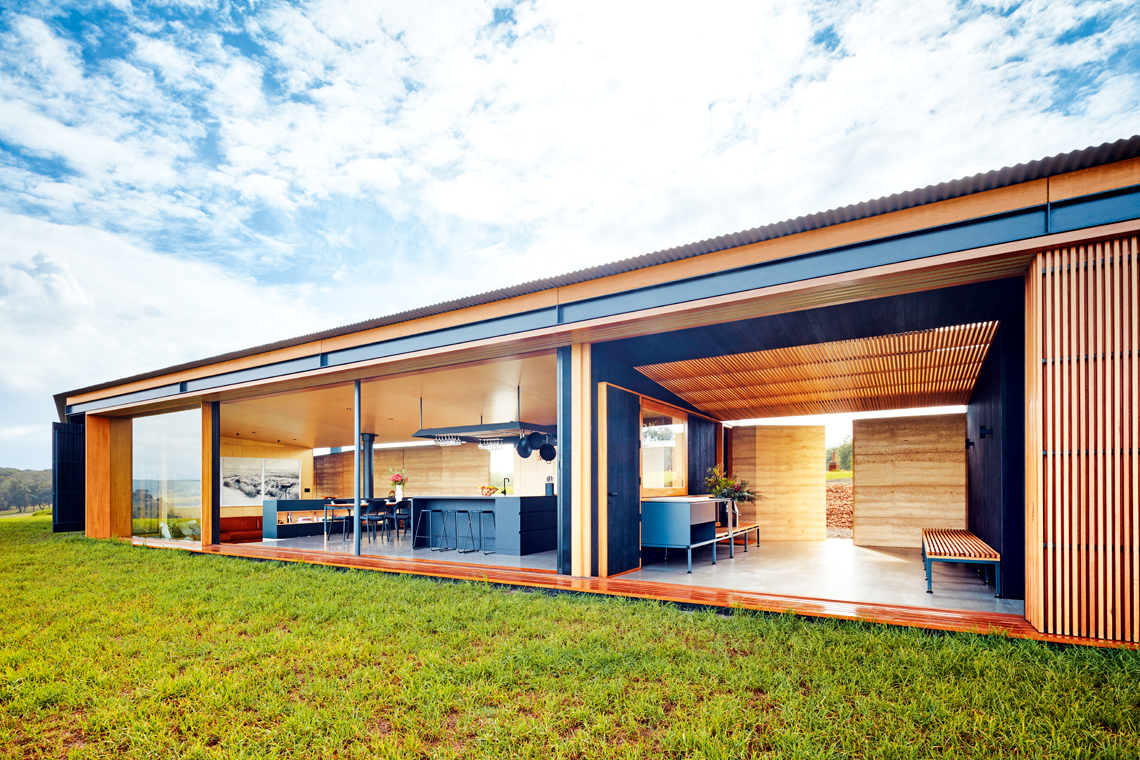When it came to choosing which way to face this sleek yet warm rural home, there was no doubt. The raw, untouched beauty of Mount Gulaga drew homeowners Rob and Sally Hawkins in as soon as they set eyes on it.
“The view across the lake to the rolling farmlands at the foot of Gulaga changes dramatically over the course of a day,” says Rob, who worked with his son Jack as the architects on the build. “There are also views south from the camp area, down the Sapphire Coast to Bermagui and beyond.”

A Home Designed for Comfort and Flexibility
Nestled at the southern end of the paddock, below natural ground level for shelter from the coastal winds, this long and dramatic home provides much-needed space for the couple, who escape to Mystery Bay to “get young not old. The house was intended as our country retreat but is increasingly becoming our family home,” says Rob. “The house, along with the local community, has proven to be an ideal place to socially distance during COVID-19 lockdowns.”
Each room has a dedicated, uninterrupted view of the grand Gulaga through floor-to-ceiling glazed windows, while a long corridor casually stretches behind each room. A striking 60m rammed-earth wall, chosen by Sally after seeing examples during their travels, flanks the back of the house, providing protection from the prevailing north-east and south-east winds. It also acts as a heat
and cool sink in both summer and winter.

Functional Spaces for Everyday Living
The recycled jarrah exterior pays homage to the numerous coastal banksia on site. As a result, it almost hides the home from a distance. Meanwhile, the birch ply lining stretches throughout the home’s interior. It complements the jarrah and also mirrors the hue of the banksias’ open seed pods.
The expansive home has three distinct areas that can be sealed off when it is not being used, something that was important to the couple who mostly live there alone. “As only Sally and I are living in the house, we wanted it split so we could shut down the guest wing when not in use, with the house staying cosy and comfortable all year round,” says Rob. “But it can also be opened up when we have guests staying in the guest wing and/or camping at the campground.”
The couple’s minimalist master bedroom includes a walk-in robe and modern granite-tiled ensuite. It’s situated at the northern end. Alongside it are the open sunken living room, dining room, and chef-style kitchen, completing the home’s main wing. The entry space and outdoor living area, along with a utility block, separate the main wing from the guest wing. This utility block contains the laundry, boiler room for hydronic heating, powder room, and carport. The southern guest wing includes two bedrooms, each with its own ensuite. It also features a separate living space with a dining area and kitchenette for visitors. This leads to a sheltered external courtyard, protected from the north-easterly wind.

Energy-Efficient Design and Sustainability
Blackbutt timber is beautifully featured throughout, surrounding the doorframes in the louvres and used in the exquisite custom-designed dining table overlooking Gulaga. These natural timbers give the house warmth and create a stunning sanctuary away from the external elements.
To protect the home from the warm western sunlight, the house has a smart and dynamic facade that consists of sliding and rotating timber-battened sunscreens that also visually meld the home into its natural landscape. Alternatively, the blackbutt-framed glazed doors and louvre windows can slide away to open up the house to the cooling elements.
“The site and Mother Gulaga were our main inspirations for the design,” says Rob. “Once we owned the property, for the first nine months we camped there many times in order to get the best feel for siting the house based on the climate, the winds and the views both from
and to the site.”

Respecting the Natural Landscape
To pay respect to the wild earthly nature of the property, the home is designed to be completely off-the-grid, including the collection of drinking water and waste disposal. “The whole house pays homage to Mount Gulaga and the indigenous Yuin people and it defers to the history of the area,” says Peter Maddison, host of Grand Designs Australia. “What I loved is how it has a deference to the location. The house sits flat in the landscape and is made from rammed earth and charred timber. The whole feel is very raw and natural.”
Water Collection and Waste Disposal System
A 600mm-wide box gutter collects the couple’s drinking water off the main house roof via a first flush diverter into three 10,000-litre drinking water tanks at either end of the home. The system pumps the water into a 100,000-litre concrete in-ground water tank near the shed for cooling and settling before it moves into the house for use. The septic tank disposes of the waste.
Solar Power and Heating System
Solar panels located on the shed roof feed power to lithium batteries, which initially powered the home’s construction. Two solar hot water panels and storage generate hot water, and three gas boosters link to the system, switching off once the water reaches the outlet.
“The house is so dynamic that we have many favourite areas depending on the time of year and time of day,” says Rob. “The sunken living room is our favourite part of the house in winter. With the fireplace burning and seated below ground level with the amazing view of Gulaga, we feel cosy and comforted in the house, the rammed-earth wall acting like our security blanket. Waking up to see the morning winter sun rise and stream through the rammed-earth wall slot window into our bedroom while watching kangaroos outside in the paddock is a joy.”














